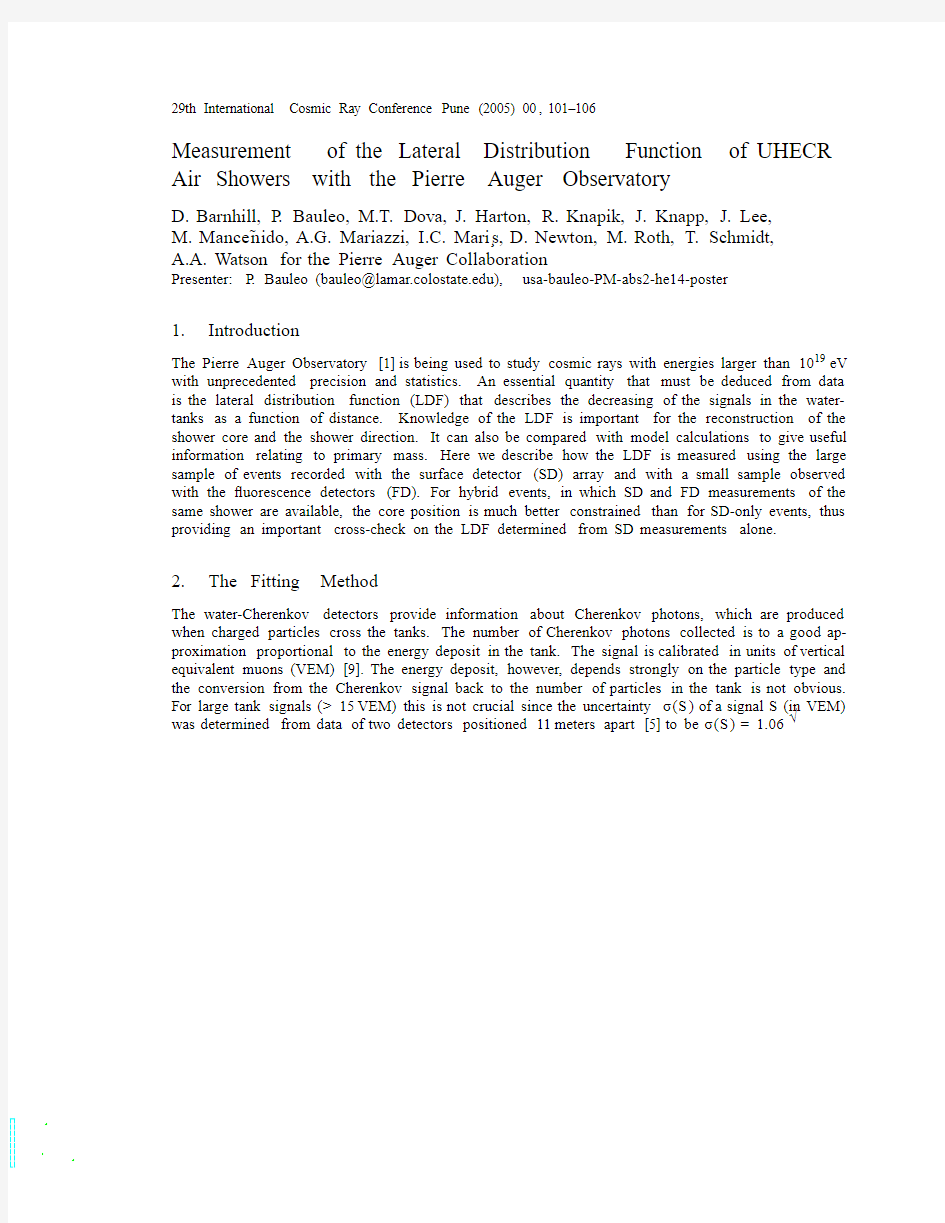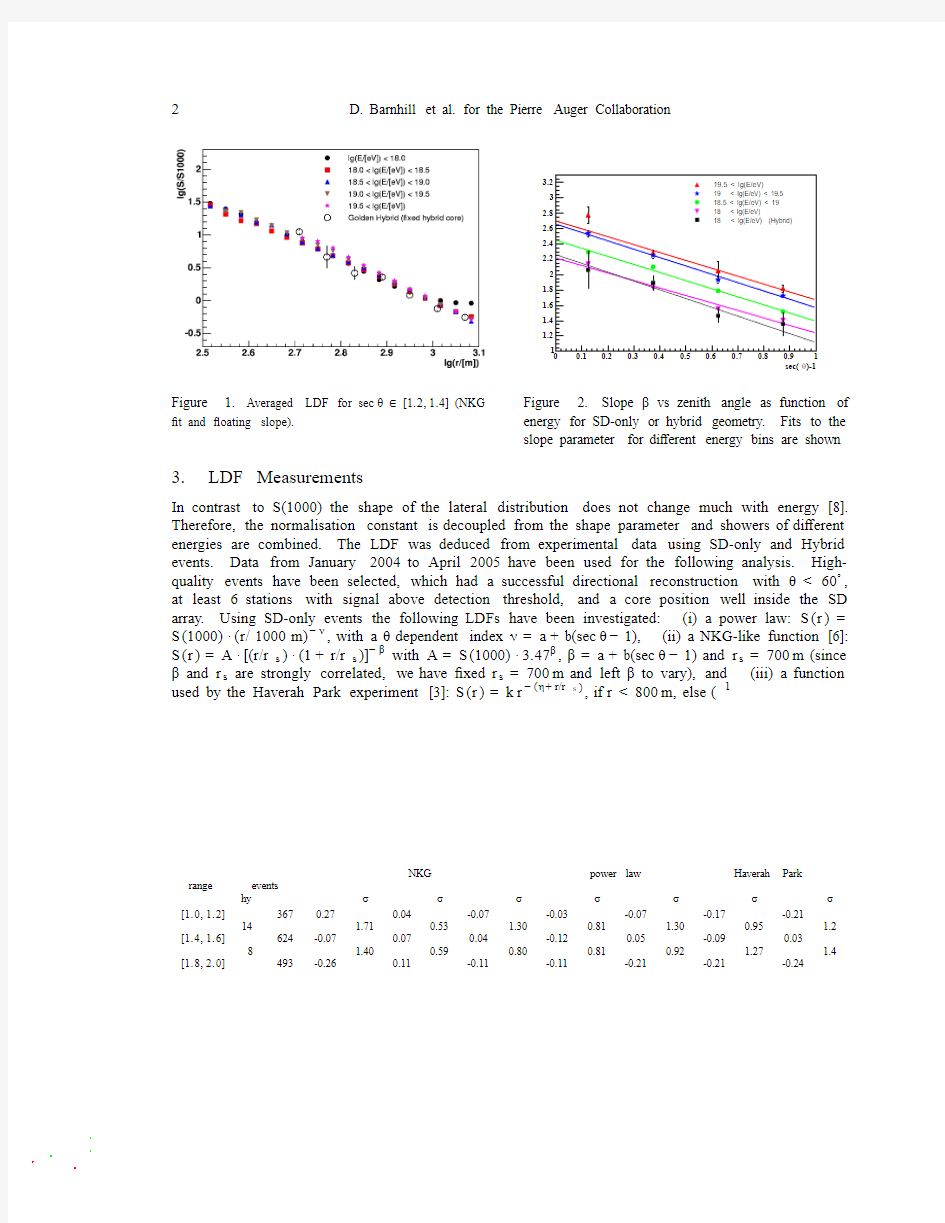Measurement of the Lateral Distribution Function of UHECR Air Showers with the Pierre Auger


a r
X
i
v
:a
s t
r o
-
p
h
/
5
7
5
9
0v
1
2
6
J u
l
2
5
29th International Cosmic Ray Conference Pune (2005)00,101–106Measurement of the Lateral Distribution Function of UHECR Air Showers with the Pierre Auger Observatory D.Barnhill,P.Bauleo,M.T.Dova,J.Harton,R.Knapik,J.Knapp,J.Lee,M.Mance?n ido,A.G.Mariazzi,I.C.Mari?s ,D.Newton,M.Roth,T.Schmidt,A.A.Watson for the Pierre Auger Collaboration Presenter:P.Bauleo (bauleo@https://www.360docs.net/doc/e08070113.html,),usa-bauleo-PM-abs2-he14-poster 1.Introduction The Pierre Auger Observatory [1]is being used to study cosmic rays with energies larger than 1019eV with unprecedented precision and statistics.An essential quantity that must be deduced from data is the lateral distribution function (LDF)that describes the decreasing of the signals in the water-tanks as a function of distance.Knowledge of the LDF is important for the reconstruction of the shower core and the shower direction.It can also be compared with model calculations to give useful information relating to primary mass.Here we describe how the LDF is measured using the large sample of events recorded with the surface detector (SD)array and with a small sample observed with the ?uorescence detectors (FD).For hybrid events,in which SD and FD measurements of the same shower are available,the core position is much better constrained than for SD-only events,thus providing an important cross-check on the LDF determined from SD measurements alone.2.The Fitting Method The water-Cherenkov detectors provide information about Cherenkov photons,which are produced when charged particles cross the tanks.The number of Cherenkov photons collected is to a good ap-proximation proportional to the energy deposit in the tank.The signal is calibrated in units of vertical equivalent muons (VEM)[9].The energy deposit,however,depends strongly on the particle type and the conversion from the Cherenkov signal back to the number of particles in the tank is not obvious.For large tank signals (>15VEM)this is not crucial since the uncertainty σ(S )of a signal S (in VEM)was determined from data of two detectors positioned 11meters apart [5]to be σ(S )=1.06√
2 D.Barnhill et al.for the Pierre Auger
Collaboration
Figure1.Averaged LDF for secθ∈[1.2,1.4](NKG ?t and?oating slope).
Figure 2.Slopeβvs zenith angle as function of energy for SD-only or hybrid geometry.Fits to the slope parameter for di?erent energy bins are shown
3.LDF Measurements
In contrast to S(1000)the shape of the lateral distribution does not change much with energy[8]. Therefore,the normalisation constant is decoupled from the shape parameter and showers of di?erent energies are combined.The LDF was deduced from experimental data using SD-only and Hybrid events.Data from January2004to April2005have been used for the following analysis.High-quality events have been selected,which had a successful directional reconstruction withθ<60?, at least6stations with signal above detection threshold,and a core position well inside the SD https://www.360docs.net/doc/e08070113.html,ing SD-only events the following LDFs have been investigated:(i)a power law:S(r)= S(1000)·(r/1000m)?ν,with aθdependent indexν=a+b(secθ?1),(ii)a NKG-like function[6]: S(r)=A·[(r/r s)·(1+r/r s)]?βwith A=S(1000)·3.47β,β=a+b(secθ?1)and r s=700m(since βand r s are strongly correlated,we have?xed r s=700m and leftβto vary),and(iii)a function used by the Haverah Park experiment[3]:S(r)=k r?(η+r/r s),if r<800m,else(1
NKG power law Haverah Park range events
hyσσσσσσσ[1.0,1.2]3670.270.04-0.07-0.03-0.07-0.17-0.21
14 1.710.53 1.300.81 1.300.95 1.2 [1.4,1.6]624-0.070.070.04-0.120.05-0.090.03
8 1.400.590.800.810.92 1.27 1.4 [1.8,2.0]493-0.260.11-0.11-0.11-0.21-0.21-0.24
Measurement of the LDF of UHECR Air Showers with the Pierre Auger Observatory3 and re?ects upward?uctuations of signals close to the trigger threshold of single tanks.In case of this NKG-like function with a free slope parameter,β,the?t results for E>1018eV are given in Table2. The energy dependence ofβis shown in Figure2and described byβ(E)=a(E)+b(secθ?1),with a(E)=2.26+0.195log10(E/EeV)and b=-0.98.To quantify the quality of the?ts the residuals, (S?S th)/σth,and their distributions are computed.For a good LDF the residuals should scatter symmetrically around0withσ=1.Means and standard deviations of the residual distribution are used to compare di?erent LDFs and are given in Table1.For simplicity only residuals up to 1500m are taken into account,resulting in a variance smaller than the expectation value of1to avoid systematic biases of upward?uctuating signals.The NKG-like function?ts the data best,which can be seen from the smallest mean residuals and the smallest residual variances.
Complementarily to the SD analysis,a hybrid LDF analysis was performed.The hybrid reconstruction exploits the independent knowledge of the core position to determine the shower axis geometry and distance from each detector to the shower core.A maximum likelihood?t(section2)is used to determine only S(1000)and the LDF slope parameter(β).A NKG-like function was studied in the hybrid analysis.
Hybrid triggers usually include a relatively large number of accidental stations,which in the case of low multiplicity events could even outnumber the number of stations that are part of the event making the identi?cation of accidentals and candidate stations a di?cult task.Therefore,strict quality cuts were imposed and only events with at least6triggered stations were included in the analysis.That reduces the sample size,but at the same time,selecting events with a large number of active stations, prevents biasing the LDF slope due to signal?uctuations.Moreover,as the quality cuts imposed
Hybrid
2.24±0.01
-0.98±0.02
4 D.Barnhill et al.for the Pierre Auger Collaboration
Figure 3.LDFs of an Auger SD event,analysed with di?erent slope parameters.Red points indicate stations with zero signal.The inset shows how the optimum ground parameter r opt varies with the array
spacing.
parameter has very little dependence on zenith an-
gle,energy,or the form of the LDF used to recon-
struct the showers.For example,an analysis of
~500Auger SD events with energies 1018.5eV
gives a distribution of r opt with mean 940m and a rms of 110m.An analysis of simulated events at 1020eV gives a mean of 930m and a rms deviation of 40m.The prescence of a saturated station (pre- dominantly in vertical,high energy events)tends to push r opt out by several hundred metres,and af- ter an analysis of many showers,at di?erent zenith angle and energy,S(1000)was chosen as a robust ground parameter to measure all showers at.At 1000m from the core the mean uncertainty in S (r ) (across all events)is minimised,and furthermore, for the few showers where r opt lies far from 1000m, the uncertainty in S(1000)can easily be estimated.5.Summary and Outlook The lateral distribution function of EAS observed using the Auger Observatory has been derived.Di?erent functions have been tested and it is concluded that an NKG-like LDF describes the data well.The dependence of the function on atmospheric depth has been described.It should be emphasized that the global shower observables,like the lateral distribution of particles,are not a?ected by the geomagnetic ?eld for zenith angles θ<70?.However,for the case of very inclined showers which are dominated by muons,the density at ground is rendered quite asymmetric by the geomagnetic ?eld and the LDF approach is not longer valid [2,7]. References [1]Abraham J.et al.,(Auger Collaboration),Nucl.Instr.Meth.A 523(2004)50-95 [2]Ave M.et al.,Astropart.Phys.14(2000)91 [3]Coy R.N.et al.,Astropart.Phys.6(1997)263 [4]Coy R.N.et al.,Proc.17th ICRC,Paris (1981)vol.6. [5]Ghia P.et al.for the Auger Collaboration,these proceedings (ita-ghia-P-abs1-he14-oral) [6]Greisen K,Progress in Cosmic Ray Physics 3(1956)North Holland Publ. Kamata K and Nishimura J.Prog.Theoret.Phys.Suppl.6(1958)93 [7]Hillas A.M.et al.,Proc.11th ICRC,Budapest (1969),Acta Physica Academiae Scietiarum Hun- garicae 29,Suppl.3,(1970)533 [8]Roth M.for the Auger Collaboration,Proc.28th ICRC,Tsukuba (2003)333. [9]Salazar H.for the Auger Collaboration,Proc.27th ICRC,Hamburg (2001)752.
